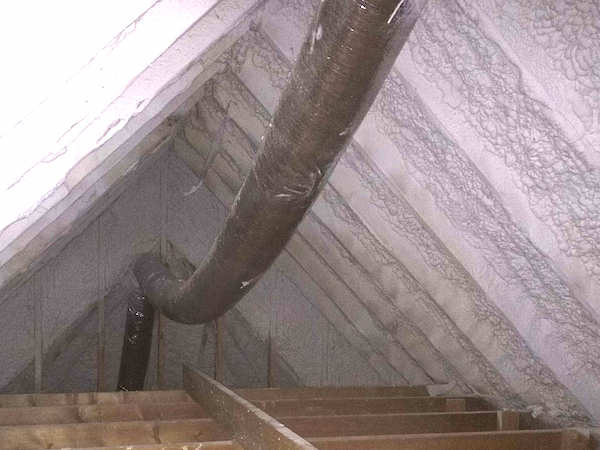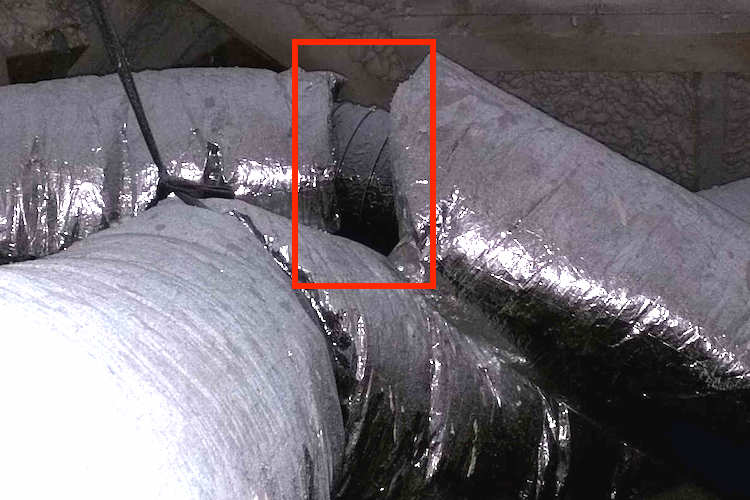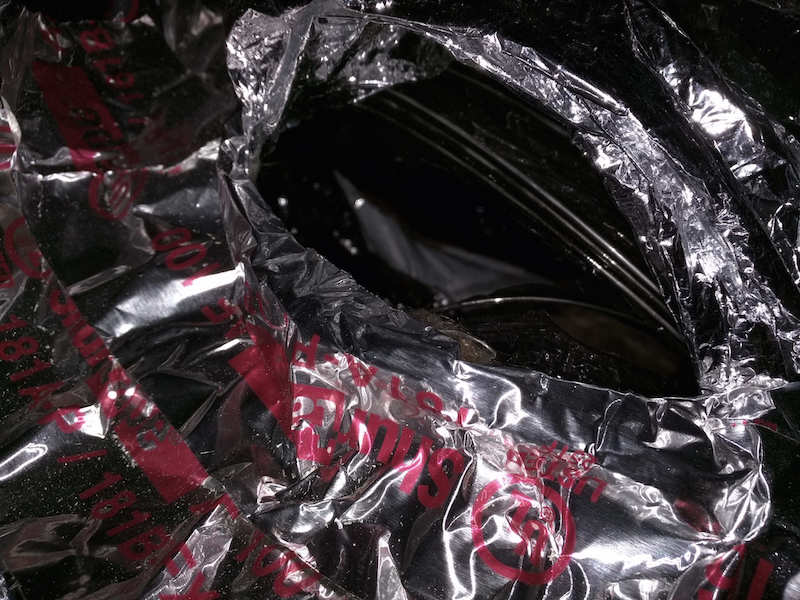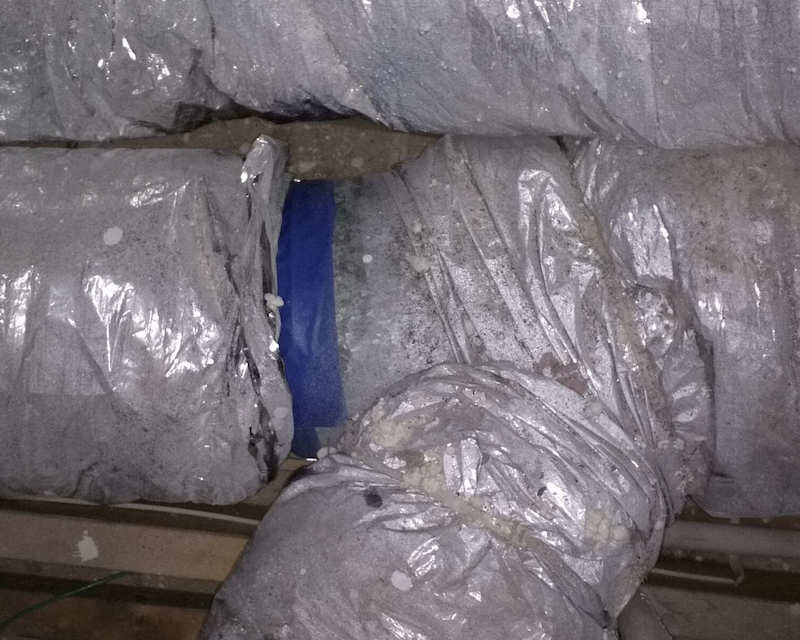Signs of a Bad Duct Installation

Last month while I was in Austin, homebuilder extraordinaire Matt Risinger gave me a tour of some of his projects. Afterward I wrote about something I saw on his new home construction site that was a sign of a good duct installer. Today I bring you a few photos that are signs of a bad duct installation. A homeowner in Atlanta was getting a home energy upgrade, and one part of it was getting a whole new duct system installed. We got called in afterward and here’s what we found.
Did they really do that?
The photo above shows one of the problems. Flex duct needs to have at least one support every four feet. If it sags, as you see here, the friction is higher and the air flow is lower. There’s good research on the problems with flex duct not pulled tight. Still, this happens a lot.
Here’s problem number 2. Well, actually this is problems 2, 3, and 4. First, what you see here is an uninsulated section of flex duct. This is a supply duct. This time of year, cold air runs inside that duct. Yes, it’s in an attic with spray foam insulation on the roofline, but still, you insulate every bit of the supply lines.

Now, the reason there’s a gap in the insulation there is that they connected two pieces of flex duct there. It’s a butt joint. And it’s a butt joint without a rigid connector. They just shoved one piece of flex inside the other. That’s a problem because these things will come apart if they’re not mechanically fastened together with a piece of rigid metal.
The third part of this problem is that they didn’t even bother to put any tape on the butt joint. Think any of that supply air is leaking out?

That barely connected butt joint in the supply duct wasn’t the only place they did this either. The photo here shows one in a return duct. The tape on the duct liner wasn’t sealed. The flex duct liner inside wasn’t connected. At least with the other one, they had two inches of overlap. Here, the two liners weren’t even touching. So that duct was sucking in attic air and sending it to the house.
The homeowner checked out the new ducts after they were installed. He noticed air leaking out so he called the duct installer back out to seal it up. Somehow they still missed the stuff above. Maybe they don’t own duct leakage testing equipment? But they did find at least one place to “seal.”

Yes, that really is blue painters’ masking tape. Definitely not approved for this use. Definitely guaranteed to fail. That’s also bare, uninsulated metal showing to the right of the tape.
How to get it done right
So, as a homeowner, you don’t always get what you want. When hiring a company to install a new duct system, however, there are some things you can do to help ensure you get a better than average system. Here are some recommendations:
- Try to find the best HVAC company you can. It’s not easy. Ask for references. Look at photos of their work. See if they’re involved in “home performance” contracting. Ask if they test their work. You want a company that understands the house-as-a-system concept. None of these things is a guarantee, but they can help you eliminate the worst contractors.
- Insist on best practices for duct installation. See my article on how to install flex duct properly. Tell them you’ll allow them to use flex duct only for straight runs and it must be pulled tight.
- Make sure they test their work. Test for leakage. Test for air flow.
- Do a visual inspection yourself. Walk through and look for the problems I showed above. Flex duct should be supported and pulled tight. All supply ducts and fittings should be insulated. Look for all seams and joints to be sealed with an approved sealant, ideally mastic.
Another thing to remember is that ducts are only part of the HVAC system. A new duct system won’t do what it’s supposed to do if it’s not designed for the heating and cooling system it’s attached to. They go together. In this home, they got new heating and cooling systems as well as new ducts.
What happened to this homeowner, though, is inexcusable. They were told they should consider getting new ducts and they did, thinking that would solve their problems. Instead, they got new ducts with probably just as many problems as the old ducts had.
If you follow the recommendations above, you stand a much better chance of getting a good duct system installed.
Related Articles
A Sign of a Good Duct Installer
The Science of Sag – Flex Duct and Air Flow
How to Install Flex Duct Properly
NOTE: Comments are moderated. Your comment will not appear below until approved.
This Post Has 24 Comments
Comments are closed.

There’s a big issue with
There’s a big issue with trying to find a good contractor: it’s a lot of work. And a second one: that contractor may not EXIST in that market, it doesn’t here. I don’t know of a single HVAC contractor in Cleveland that uses a duct blaster. I only know of one duct blaster in town (I don’t even have one.)
To me, the only likely solution to this is to find a good auditor and pay them to help you through the process. There are two problems there, though. First the auditors may not exist, or only want to be involved in test in/test out and not during finding contractors and watching work. Second, few homeowners understand the problems caused by shoddy work up front, so they aren’t willing to pay that auditor.
Basically, the whole thing is a crap sandwich. We can make it better through education, which Allison you do a very good job of. In my mind there needs to be a homeowner guide to duct systems. Better still, it would be part of a larger book so that homeowners could understand that duct systems are just one part of a large interconnected system of systems called a home.
The other thing that’s needed are hard metrics for homeowners to be able to tell a good contractor from a bad one. Right now best liar wins. If one HVAC contractor consistently has lower leakage numbers (which requires measuring and reporting) and lower EUI (usage per square foot per year) than others, you have some real metrics to sink your teeth into.
Until actual measurement and better consumer education exists, this problem is NOT getting solved. I’m working on both…
Getting local Hvac to do a
Getting local Hvac to do a load calculation is not welcomed in my area. They eyeball the unit, then the house and say ‘looks good’.
Same with ducting. I had two different companies come to look at my ducting and they ignored obvious sag, mold growing on flex, condensation water pooling in one sagging flex, and poorly taped connections. The industry ought be embarrassed by the hacks, the lazy, and the undereducated ‘technicians’ saturating the market.
Duct air flow testing should be standard practice. I don’t understand how ducting is allowed to be assembled but not verified for performance.
I doubt the companies in my area know how to test duct performance nor even have the tools to do the test. I bet asking for a test would be followed with ‘what is it you need again?’ like I’m talking in a foreign language.
I hope those that care,like Allison, continue to raise the standards for the industry
UL 181 tape!
UL 181 tape!
Q: Speaking of Austin, any
Q: Speaking of Austin, any feedback from the Humid/Warm Climate Passivehaus conference?
Bad work, like bad golf, is
Bad work, like bad golf, is pretty obvious.
But good work, like good golf, requires scorekeeping.
Good golfers have their scores publicly posted, and get recognized and rewarded for their good golf. Without this reward, do you think there would be many “good golfers?” How would you find one?
Until we publicly post our scores, not only will it be impossible to reliably get good work, there will be no reward for it.
http://bit.ly/ESHPOhioProjects – anybody else got a scorecard?
Allison,
Allison,
I could go on and on about this problem but instead have a question. HVAC install seems to be struggle across the board, mostly because design and commissioning aren’t even in the picture. It often makes me want to just do it myself, although that really isn’t the best course action. In a recent blog you said one of Energy Vanguard’s services is HVAC design. I’m a licensed builder, RESNET and BPI certified, and have been doing home performance full time for 7 years, but what would you say are the necessary credentials to do residential HVAC design? I design it, they install it, I commission it seems like a better model than I’ve be working with. Thanks in advance.
Just an observation &
Just an observation & wondering if it is happening elsewhere. ALL HVAC Companies in the Hilton Head/ Bluffton, SC area use to have “HVAC” (and sometimes “R”) written on their company signage. NOW, they seem to all have dropped the “V” (advertising heating & cooling). Wondering if insurance companies have insisted upon this to counter potential lawsuits for mold etc … any comments?
“Test for leakage”
“Test for leakage”
“Test for air flow”
Sweet words and I would dearly like for that to be available to the average home owner. But it seems exotic vs. what nearly everybody does where I live. I am literally the only person I know who has had air flow testing on every part of the duct system.
What you recommend, does it require a duct blaster and a flow hood used for every new duct system? Is there any other way?
I think this subject should be dissected and broken down into its elements, in order for even the nerd homeowner to have a chance of getting this done right. Too few HVAC companies have any kind of engineer on staff, and this really is an engineering problem.
Keep in mind the most common
Keep in mind the most common practice is to simply oversize the HVAC unit so the lack of delivered performance isnt noticed by the homeoowner.
On a positive note, since
On a positive note, since these folks sealed up their attic with spray foam I could argue having some air leakage on the supply side and a little sucking on the return side might actually be good for this space.
Do you have any articles that address air quality issues in sealed attics? Thanks! Good article….
This issue is a dead horse –
This issue is a dead horse – beating will not change the situation. RE: customer education – you will not make someone interested in a topic if they are not originally. RE: testing, quality trade work, reporting, etc. – customers obviously are looking for the third project solution (good, quick, cheap – pick one); doing these things will make the solution much, much more expensive. The obvious solution is the one most fight against – elevating building codes so that they affect all building projects, reflect the best industry practice, and are universally applicable (not driven by each and every locality). Then you will not need to make homeowners into building scientists, nor search for quality tradespeople, nor debate what is “proper”. Then, “built to code” will actually mean something good.
I’m with David Eakin –
I’m with David Eakin – building codes need to be upgraded to protect customers. And if the building codes require sufficient air sealing and insulation, then other options that don’t require big systems, or even ducts, become viable. See, e.g., minisplits. Just say no to ducts…except for your ventilation system…and even then I’m leaning toward the simplicity of a Lunos-type solution.
Does the City of Atlanta
Does the City of Atlanta enforce the current IECC? In Corpus Christi, TX, 3rd party code compliance companies are required to submit documentation (blower door/duct blaster test results) to development services/building dept. I have heard some municipalities that have adopted code, but enforcement is another issue.
Touché, BSC has recommended
Touché, BSC has recommended in the past that a small return and supply vent be installed in unvented attics that were sealed with ocSPF.
Great point, Dave. I should
Great point, Dave. I should have mentioned that in the article, but here’s the best article on the topic of duct leakage in spray foam attics:
Cool Hand Luke Meets Attics, by Joseph Lstiburek, PhD, PE
http://buildingscience.com/documents/insights/bsi-077-cool-hand-luke-meets-attics
I have yet to meet a
I have yet to meet a traditional HVAC company (non Home Performance) that owns a duct blaster. In fact, I asked a person with 30 years in the HVAC trade about manometers, he didn’t own one. CA added duct testing to the inspection process several years ago and what happened? HVAC installers stopped pulling permits. Duct issues are huge – I would bet that enforcing duct testing would save more energy than many of the current rebate programs. Bottom line – get the ducts tested or find a different contractor.
1. Builders and architects
1. Builders and architects should take responsibility upfront including ensuring all ductwork is detailed in the plans and is installed within the envelope (no unseled attics and especially no crawlspaces)
2. Rigid ducts should be specified and installed
3. Flex should only be used for short connections to the registers
4. Testing should be almost redundant to good design
There is a pretty big problem
There is a pretty big problem within the HVAC industry of having things done properly. Duct work can be one such area of concern. I think the reasons many of these problems exist is the nature of the beast in pricing the work that will be done.
People looking at a quote see “all visible duct work replaced” for $xxxx and then compare this to other quotes. If they get a quote or two with fancy terms thrown in there as to what will be done and the price is double maybe even triple from what the low ball quote is, guess who wins the job?
Duct work is boring to a customer, they know the conditioned air runs thru the duct to reach their habited space but other than that they will refuse to look much further.
What further complicates this is the condition of the housing market. There has been literally an explosion of house rentals over the past several years. The rental market (any rental) is in the business of counting beans. The landlord is not interested in duct blasting, air leakage, duct hung every 4 foot etc.
They are interested in the cheapest job they can find. That is the reality of this market. People can pretty much price duct work out themselves by going to home depot, so they can see the cost of materials what they don’t see is the labor intensive job in an attic many times that has nothing but rafters, which only adds more labor intensive attributes to an already labor intensive job.
Just a few days ago I got a call in which some home owner had bought equipment on line and he was calling me because his supposed friend who “that was licensed” didn’t have the tools necessary to do the job, so he was wanting to rent my tools.
All that and in the middle of summer. So the problems of the HVAC market run deep. You have people out there that want it done right, but the vast majority don’t want to pay for anything a professional has to offer.
PS: If you call me, I know you are not a licensed HVAC Contractor. A Licensed HVAC contractor would never call me, and if they did I would tell them to go break the gumball machine they got their license from.
As I’ve watched the HVAC
As I’ve watched the HVAC tradespeople struggle with sealing ducts for at least the last 15 years here in energy-code-serious Title-24 California, I’ve often wondered why the manufacturers can’t come up with fittings equivalent to PEX tubing plumbers use, or the “shark-bite” fittings that slip over and seal copper tubing.
Is the length of flex duct on
Is the length of flex duct on each run spec on HVAC design or is it installers (mis)choice. Is flex duct attahced to register boot the design choice for flow or vibe/noise isolation. The isulation sheathing on the flexduct is pretty cheesey. What right R rating is best for crawl space ducts in southeast? Is double wrapping the solution to prevent condesation or Should I just ensure there is 100% no leakage in any supply/return duct or both? We keep our house cool and AC runs a lot. Now the cral space ducts are dripping. Seems the only way to ensure success is for me to go over the duct inch by inch myself and ensure they are dry on outside, sealed and wrapped right.I have seen posts saying some of these leaks are saving overdesigned system from overpressurization or underpressurization. I had my ducts in vented crawl space replaced several years ago and they replace with similar lengths of flex duct. I have one run of about 20 ft (not very straight) flex (close to what was in the original install. If it is spec’d as flex what is impact if I replace the longer runs with metal duct? Do I need flex near boots to minimize noise/vibration. am I better with a 45 or 90 on the boot?attached to flex on the short runs to the terminals
Also should register boots be extended when installing new flooring which is higher.
John, you should reread the
John, you should reread the last section of the article “How to Get it Done Right” and it’s links. Cliff Notes version: Metal ducts with 100% mastic sealing and heavily insulated is the best if you don’t want the gold standard which is to get the ducts into a conditioned space. In your case conditioned space probably means sealing the crawlspace. Flex duct is easy and may reduce noise in short runs but is also easy to damage and generate condensate.
Seems like it is time to come
Seems like it is time to come on the market with a “duct lube spray” that will smooth out any issued in in the system and provide flow like a proper laxative. Think l could make big bucks on such a product….:)
Allison, A newbie here,
Allison, A newbie here, still learning how to post.
Im a homeowner in the Pacific NW with a 1300 sf L shaped rambler. After a critter infestation (yep they got inside) I removed the duct work. Knowing things were just spec’d in with this 1960 house, I did some research and using my old Fire Science Hydraulics designed my system for max air flow according to room size, and friction loss. When I finished the design, and I had a few Furnace companies look at it, they all told me it was too much work, and a great design but not worth it, cuz it’s just a house… As a part of the design, Im running heat to the 434 sf that was electric heat.
Im now trying to upgrade the returns as well.
Thanks for the info here, it has been helpful.
I just had a new heat and air
I just had a new heat and air package installed with all new ductwork. Some of my supply line and some of my flexible line is laying on the dirt under my house. Is this acceptable practice?